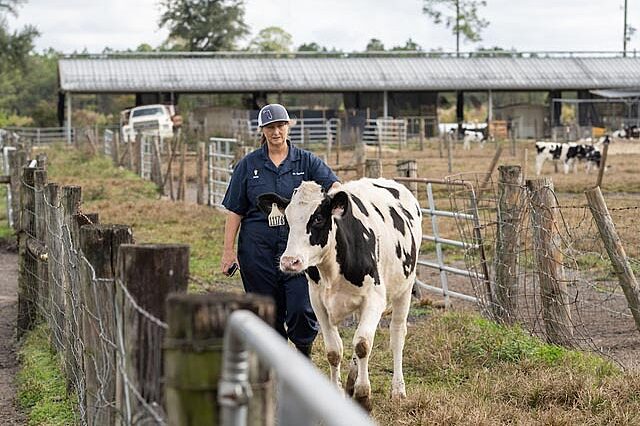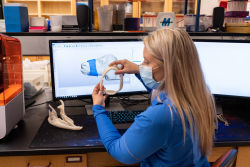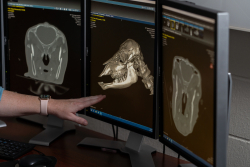Jaw-dropping recovery: UF veterinarians save injured dairy calf using creative 3D solution
A newborn dairy calf that sustained a broken jaw injury soon after birth was successfully treated by a by a team of veterinarians from the University of Florida College of Veterinary Medicine.

Thanks to a creative solution devised by University of Florida veterinarians using 3D printing technology, a newborn calf that sustained a broken lower jaw soon after birth at the UF dairy farm in Hague has fully recovered and is now an 11-month-old growing heifer in the herd.
“We were at the farm soon after she was born, and the staff asked us to look at her because she was standing with her mouth hanging open,” said Fiona Maunsell, BV.Sc., Ph.D., a clinical assistant professor with the UF College of Veterinary Medicine’s food animal reproduction and medicine service. Veterinarians from the service regularly visit the farm, run by UF’s Institute of Food and Agricultural Sciences and located in Hague, Florida, to provide care for its dairy cows and calves.
The day the calf was born, it was seen trying to first stand after birth and nose-diving forward, hitting the ground right on the end of her chin, Maunsell said. Although farm staff initially thought the injury was minor, when the UF team examined the calf more closely, they determined she had a broken lower jaw.
Maunsell said thousands of calves take their first steps every day, and almost all of them fall down multiple times in the process.
“This is the first time I’ve ever had a calf do this,” she said. “She was very feisty, though, running around her pen. And if you helped hold her mouth closed, she was able to nurse fine from a bottle.”
Although veterinarians are often able to repair breaks in the lower jaw in the field when they are at the front of the jaw, adjacent to or between the front teeth, this calf’s break appeared to be on both sides at the back of the jaw.
 “That’s not something we could repair with field anesthesia and surgery,” Maunsell said. She then contacted two of UF’s large animal surgeons to see if she could send the calf for radiographs and an evaluation.
“That’s not something we could repair with field anesthesia and surgery,” Maunsell said. She then contacted two of UF’s large animal surgeons to see if she could send the calf for radiographs and an evaluation.
The large animal team agreed to see her, and the calf arrived at UF’s Large Animal Hospital as an emergency case on Jan. 7. When radiographs did not shed much light on her injury, the surgical team recommended a CT scan, which involves multiplanar imaging and very effectively showed the bilateral breaks.
“The options for treating a calf with this type of fracture are orthopaedic surgery, which was not economically feasible, conservative management with stabilization of the jaw, or euthanasia,” Maunsell said. “Given that she has had such a great attitude, we thought we’d try conservative management.”
Working with Hongjia He, a graduate student in the Surgical Translation and 3D Printing Research Laboratory run by Adam Biedrzycki, D.V.M., an assistant professor of large animal surgery, large animal surgery resident Heather Roe, D.V.M., sat down and built a jaw “cast” for the calf veterinary technicians named “Potato.”
“We used medical tape to hold her mouth closed to stabilize her jaw, but still allow her to nurse,” said Taralyn McCarrel, an assistant professor of large animal surgery, who worked with Roe on the case. “The tape was challenging to reset with Potato’s feisty nature and started to irritate her skin, whereas the cast placed in a similar fashion was much easier to reset.”
Roe knew Potato would grow rapidly, so she assumed that they could adjust the initial 3D model to make it larger as she grew out of each cast, which is what the team wound up doing.
“The 3D print is made of a hard plastic, so we cushioned the print with cotton,” she said, adding that the final product came about through trial and error.
“The goal was to have something that stabilized her jaw so that the bone ends could heal together, allowed the calf to drink milk and was also taken on and off to clean as needed,” Roe said. “She was very wiggly, so having a cast that was easily applicable was important.”
After a few days, the calf was sent home, and follow-up imaging at one- and two-month intervals revealed that Potato’s fractures were healing well.
A second CT at the two-month recheck showed that the fracture lines were almost fully healed and her jaw was stable on palpation, so the cast was removed.
 “Our most recent recheck revealed that Potato has been thriving in her farm environment, with normal jaw function that has allowed her to continue to grow well,” Maunsell said. “Because her ordeal in early life meant a delay in moving from milk to solid food, she is about a month behind her herd-mates in development, but we now fully expect her to go on to become a valued — and much loved — member of the adult herd.”
“Our most recent recheck revealed that Potato has been thriving in her farm environment, with normal jaw function that has allowed her to continue to grow well,” Maunsell said. “Because her ordeal in early life meant a delay in moving from milk to solid food, she is about a month behind her herd-mates in development, but we now fully expect her to go on to become a valued — and much loved — member of the adult herd.”
Potato’s case was a great example of how teamwork between UF’s food animal and large animal surgery teams and the UF/IFAS dairy farm staff resulted in an innovative solution to a challenging problem, ultimately saving the calf’s life, Maunsell added.
“This calf’s case was particularly rewarding, because for her, it meant life and death,” Roe said. “Farm animals do not often have the financial backing to go to surgery, being production animals, and don’t have the ability to receive intensive care on the farm.”
Aside from financial considerations, surgery in Potato’s case would have come with a high risk of serious complications due to her bilateral fractures and important nerves located in the jaw region, and because the bone in that area is soft and thin and may not have held implants well, McCarrel said.
“Even without any financial limitations, surgery would not have necessarily guaranteed a positive outcome,” she said.
The calf’s treatment was affordable, straightforward, noninvasive, adjustable and practical, the surgeons said.
“Potato was a joy to work with, so having her in the hospital was a delight,” Roe said.
Media contact: Ken Garcia at kdgarcia@ufl.edu or 352-265-9408
About the author
